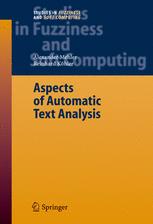

Most ebook files are in PDF format, so you can easily read them using various software such as Foxit Reader or directly on the Google Chrome browser.
Some ebook files are released by publishers in other formats such as .awz, .mobi, .epub, .fb2, etc. You may need to install specific software to read these formats on mobile/PC, such as Calibre.
Please read the tutorial at this link: https://ebookbell.com/faq
We offer FREE conversion to the popular formats you request; however, this may take some time. Therefore, right after payment, please email us, and we will try to provide the service as quickly as possible.
For some exceptional file formats or broken links (if any), please refrain from opening any disputes. Instead, email us first, and we will try to assist within a maximum of 6 hours.
EbookBell Team

0.0
0 reviewsThe significance of natural language texts as the prime information structure for the management and dissemination of knowledge is - as the rise of the web shows - still increasing. Making relevant texts available in different contexts is of primary importance for efficient task completion in academic and industrial settings. Meeting this demand requires automatic form and content based processing of texts, which enables to reconstruct or even to explore the dynamic relationship of language system, text event and context type. The rise of new application areas, disciplines and methods (e.g. text and web mining) testify to the importance of this task. Moreover, the growing area of new media demands the further development of methods of text analysis with respect to their computational linguistic, information theoretical, and mathematical underpinning. This book contributes to this task. It collects contributions of authors from a multidisciplinary area who focus on the topic of automatic text analysis from several (i.e. linguistic, mathematical, and information theoretical) perspectives. It describes methodological as well as methodical foundations and collects approaches in the field of text and corpus linguistics. In this sense, it contributes to the computational linguistic and information theoretical grounding of automatic text analysis.